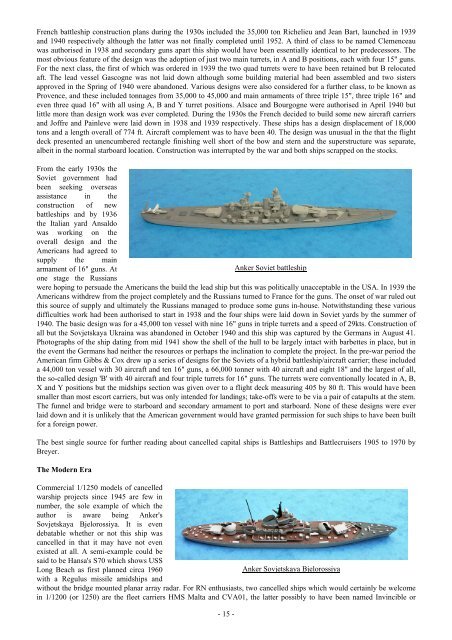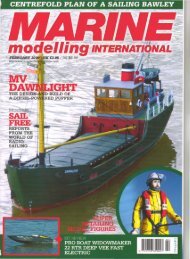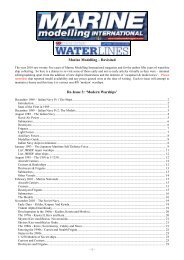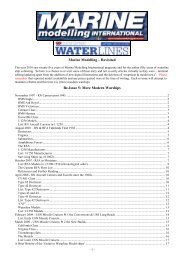Marine Modelling â Revisited Re-Issue 2: 'Foreign Warships'
Marine Modelling â Revisited Re-Issue 2: 'Foreign Warships'
Marine Modelling â Revisited Re-Issue 2: 'Foreign Warships'
You also want an ePaper? Increase the reach of your titles
YUMPU automatically turns print PDFs into web optimized ePapers that Google loves.
French battleship construction plans during the 1930s included the 35,000 ton Richelieu and Jean Bart, launched in 1939<br />
and 1940 respectively although the latter was not finally completed until 1952. A third of class to be named Clemenceau<br />
was authorised in 1938 and secondary guns apart this ship would have been essentially identical to her predecessors. The<br />
most obvious feature of the design was the adoption of just two main turrets, in A and B positions, each with four 15" guns.<br />
For the next class, the first of which was ordered in 1939 the two quad turrets were to have been retained but B relocated<br />
aft. The lead vessel Gascogne was not laid down although some building material had been assembled and two sisters<br />
approved in the Spring of 1940 were abandoned. Various designs were also considered for a further class, to be known as<br />
Provence, and these included tonnages from 35,000 to 45,000 and main armaments of three triple 15", three triple 16" and<br />
even three quad 16" with all using A, B and Y turret positions. Alsace and Bourgogne were authorised in April 1940 but<br />
little more than design work was ever completed. During the 1930s the French decided to build some new aircraft carriers<br />
and Joffre and Painleve were laid down in 1938 and 1939 respectively. These ships has a design displacement of 18,000<br />
tons and a length overall of 774 ft. Aircraft complement was to have been 40. The design was unusual in the that the flight<br />
deck presented an unencumbered rectangle finishing well short of the bow and stern and the superstructure was separate,<br />
albeit in the normal starboard location. Construction was interrupted by the war and both ships scrapped on the stocks.<br />
From the early 1930s the<br />
Soviet government had<br />
been seeking overseas<br />
assistance in the<br />
construction of new<br />
battleships and by 1936<br />
the Italian yard Ansaldo<br />
was working on the<br />
overall design and the<br />
Americans had agreed to<br />
supply the main<br />
armament of 16" guns. At<br />
Anker Soviet battleship<br />
one stage the Russians<br />
were hoping to persuade the Americans the build the lead ship but this was politically unacceptable in the USA. In 1939 the<br />
Americans withdrew from the project completely and the Russians turned to France for the guns. The onset of war ruled out<br />
this source of supply and ultimately the Russians managed to produce some guns in-house. Notwithstanding these various<br />
difficulties work had been authorised to start in 1938 and the four ships were laid down in Soviet yards by the summer of<br />
1940. The basic design was for a 45,000 ton vessel with nine 16" guns in triple turrets and a speed of 29kts. Construction of<br />
all but the Sovjetskaya Ukraina was abandoned in October 1940 and this ship was captured by the Germans in August 41.<br />
Photographs of the ship dating from mid 1941 show the shell of the hull to be largely intact with barbettes in place, but in<br />
the event the Germans had neither the resources or perhaps the inclination to complete the project. In the pre-war period the<br />
American firm Gibbs & Cox drew up a series of designs for the Soviets of a hybrid battleship/aircraft carrier; these included<br />
a 44,000 ton vessel with 30 aircraft and ten 16" guns, a 66,000 tonner with 40 aircraft and eight 18" and the largest of all,<br />
the so-called design 'B' with 40 aircraft and four triple turrets for 16" guns. The turrets were conventionally located in A, B,<br />
X and Y positions but the midships section was given over to a flight deck measuring 405 by 80 ft. This would have been<br />
smaller than most escort carriers, but was only intended for landings; take-offs were to be via a pair of catapults at the stern.<br />
The funnel and bridge were to starboard and secondary armament to port and starboard. None of these designs were ever<br />
laid down and it is unlikely that the American government would have granted permission for such ships to have been built<br />
for a foreign power.<br />
The best single source for further reading about cancelled capital ships is Battleships and Battlecruisers 1905 to 1970 by<br />
Breyer.<br />
The Modern Era<br />
Commercial 1/1250 models of cancelled<br />
warship projects since 1945 are few in<br />
number, the sole example of which the<br />
author is aware being Anker's<br />
Sovjetskaya Bjelorossiya. It is even<br />
debatable whether or not this ship was<br />
cancelled in that it may have not even<br />
existed at all. A semi-example could be<br />
said to be Hansa's S70 which shows USS<br />
Long Beach as first planned circa 1960<br />
Anker Sovjetskaya Bjelorossiya<br />
with a <strong>Re</strong>gulus missile amidships and<br />
without the bridge mounted planar array radar. For RN enthusiasts, two cancelled ships which would certainly be welcome<br />
in 1/1200 (or 1250) are the fleet carriers HMS Malta and CVA01, the latter possibly to have been named Invincible or<br />
- 15 -







